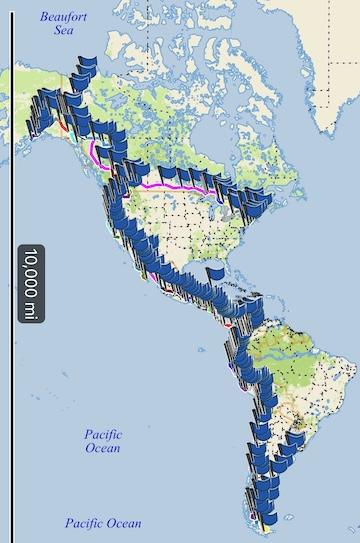On July 1, 2022, I closed the door on my Philadelphia row home and moved with my partner and our daughter into the Ford Transit campervan parked outside. After 18 months of designing and outfitting the van, we took the first of many long roads ahead.
The first month took us west and north across Canada to the shores of the Arctic Ocean in the First Nations village of Tuktoyaktuk (yes, we jumped in!). We were at the beginning of the Pan-American Highway, “the longest road in the world” connecting North, Central and South America. Over the next 12 months, we mostly headed South toward the Patagonia region in Chile, Argentina and Ushuaia, the world’s southernmost city.
Early on, near a blueberry farm in Ontario, a stranger asked me, “What do you hope your daughter gets out of this trip?” I wasn’t yet sure I knew what any of us would get out of it.
I replied, “I guess I hope that, in the end, she sees that we’re not alone and that we can’t do this, any of this, alone.”
The Pan-American Highway isn’t just “a road” — it’s actually not even continuous — it is a metaphor for connection. It’s a pathway to new experiences, new landscapes, new languages, new people. We awakened countless mornings to the sound of waves (and one time to a full-blown school musical performance, with an audience, in the parking lot next to us!) instead of a beeping alarm.
We climbed misty mountains, soaked in turquoise pools and bubbling hot springs, skied in July, visited museums and cave paintings, tried new foods and made new friends. We were often dependent on complete strangers for guidance, help and companionship.
Though we never felt unsafe, we did sometimes find it hard planning almost daily for our next stop or campsite, trying to stay in the moment while planning the next step. We navigated roads paved and unpaved, roads well-traveled and less so. We slept in a small van, but the world outside was our living room and our playground. Whether we put our foot on the gas or stopped and opened our doors, curiosity was our guide.
As a traveler, I can’t see around every corner, but guided by curiosity rather than judgment, I remain open to what awaits. As travelers, we must be ready to take some risks, to live on the growth margin and to try to compose sentences in languages we are learning. We may sometimes cry out in frustration or jump for joy when we encounter the overwhelming beauty of the unexpected: an erupting volcano, a radiant sunset, a gentle snowfall, a kindness. When we reach the boundaries of the familiar and step beyond them, we open ourselves to possibility, and from there, we can go anywhere.
To see photos of Abbas and her family on the Pan-American Highway, visit @hihosilver.van on Instagram. Amber Abbas, Ph.D., is an associate professor of history and the director of the Asian Studies Program.














































